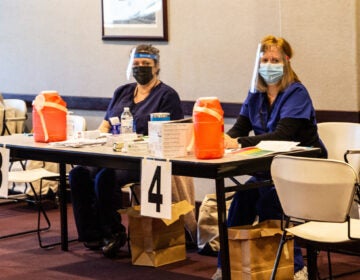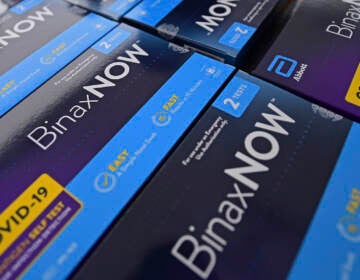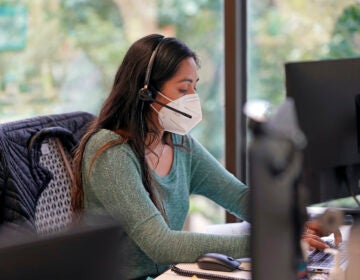How contact tracers keep up with the surge in COVID-19 cases
All those new positive cases means a shift in priorities, as CDC guidelines also have shifted.
Listen 1:48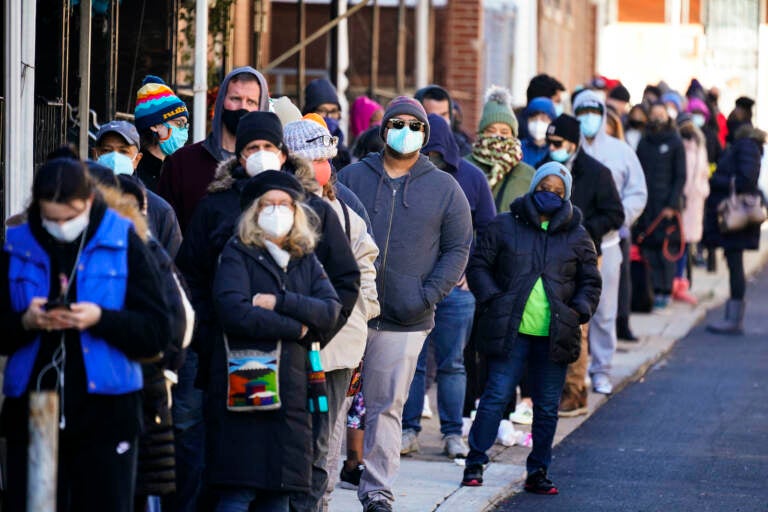
City residents wait in a line extending around the block to receive free at-home rapid COVID-19 test kits in Philadelphia, Monday, Dec. 20, 2021. (AP Photo/Matt Rourke)
Ask us about COVID-19: What questions do you have about the coronavirus and vaccines?
Tonia Bullard has been a contact tracer in Philadelphia since 2020, and she’s never been as busy as she is now.
“This time, it’s been probably the largest surge that I can remember since I’ve been working here,” she said.
Bullard still finds the job rewarding: telling people who tested positive when they can return to work, when their children can go back to school, and how they can prevent spreading the coronavirus to other people.
Late last year, Philadelphia, along with Pennsylvania as a whole and the rest of the country, started to see a spike in cases. As a result, contact tracers have to prioritize calls, because it’s now impossible to call everybody who tested positive, said James Garrow, director of communications for the Philadelphia Department of Public Health.
The city, like Montgomery County and the state of Delaware, is prioritizing contact tracing calls to prevent the virus from spreading among children at schools and daycare centers, and among people at risk who live together, such as in nursing homes.
In late 2021, the Centers for Disease Control and Prevention changed its guidelines for isolation, recommending that people who test positive isolate for five days instead of 10. That meant contact tracers around the country had to change their scripts, leading to some confusion.
Nancy Rapoport, a retired nurse and contact tracer in Montgomery County, said they have to account for people being tired of changes to the guidelines.
“We understand it can be confusing and frustrating for people, and we try to express to the people, that’s why we’re here,” she said. “We’re here to help you sort it out, there’s no reason to get frustrated, there’s no reason to get angry.”
In some instances though, such as in Delaware, contact tracers did not have access to updated scripts fast enough to reflect the new CDC guidance, so they would be telling people to isolate for 10 days, but then also mention the CDC guidance of five days and ask people to follow that.
People who tested positive also called to report that after five days of isolation, they still had symptoms of COVID-19, but that their employers were asking them to go back to work. In those situations, contact tracers could only send people to the state website with instructions for employers.
The Delaware Division of Public Health said it had to update a code in its systems before its guidance could reflect the new directions from the CDC. Delaware used to send people who tested positive a clearance letter after their isolation time was up and they could go back to work or school. People still ask for them, but the state stopped doing that because there have been so many positive cases during the recent surge.
Philadelphia, Montgomery County, and Delaware all say the priority is to prevent hospitals from being overwhelmed with COVID-19 patients, and to prevent people from dying of the illness. Emily Gurley, an epidemiologist at the Johns Hopkins Bloomberg School of Public Health, said that contact tracing is still a useful tool, but that unlike in 2020, it is no longer the only tool, so the United States overall should think about what the goal of the COVID-19 response should be.
“This is a criticism for the entire pandemic response: We’ve never really articulated what our goal is,” Gurley said. “Reduce as many infections as possible? It’s not quantifiable. There’s no: OK, are we succeeding or not? We need more transparent guidance so that we can craft a response going forward.”
In her opinion, Gurley said, the goal should focus on severe disease, hospitalizations, and deaths, and that should guide local governments on how to spend their resources, such as their contact tracing teams.
“Our systems really aren’t set up for that right now, we would need a shift in focus,” she said.
For example, Gurley said, there should be broad access to quick testing, and contact tracing so people in high-risk groups can quickly know if they have been exposed to the virus.
“Instead of calling someone and asking them to do something, like ‘Please, can you quarantine?’ we would be calling to offer something: ‘You’ve been exposed … here are your free rapid test kits, if you get sick, please test right away, and if you’re positive, here’s where you go to get your treatment, we want to be sure that your illness doesn’t progress.’”
“We have interventions that carry a cost on individuals, on communities, on society,” Gurley said. “I think it’s best when we articulate clearly what we’re trying to get for that cost, where we are trying to go.”

Get daily updates from WHYY News!
WHYY is your source for fact-based, in-depth journalism and information. As a nonprofit organization, we rely on financial support from readers like you. Please give today.




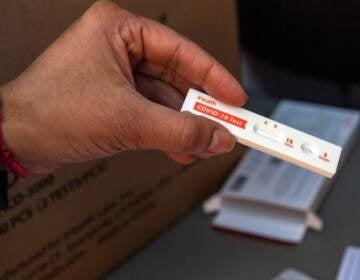
![CoronavirusPandemic_1024x512[1]](https://whyy.org/wp-content/uploads/2020/03/CoronavirusPandemic_1024x5121-300x150.jpg)
